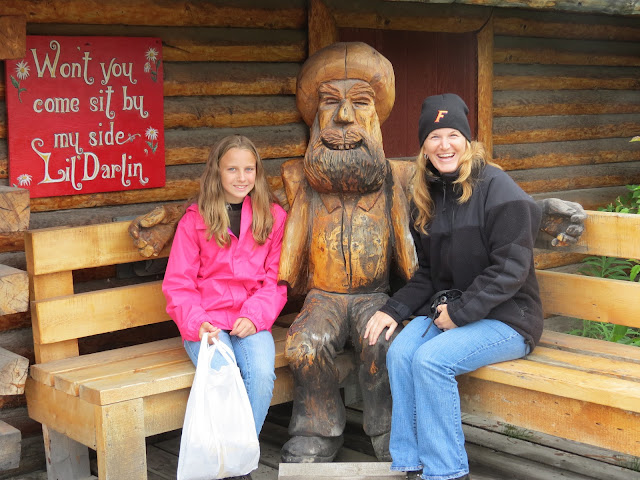Nenana's main claim to fame is the annual Ice Classic. Jennifer and Ashley are standing in front of the famous Tripod.
It is placed on the ice in the river and attached to a timepiece in this structure. When the ice goes out in the spring, the Tripod topples and the clock stops. People buy tickets and try to guess the exact day and time the ice will go out. I have my ticket.
Joanne Hawkins in the Gift Shop still has her accordion, and if you ask her, she will play a tune for you. She has written a book about her life in Alaska since I was last here. I am reading it now. Alaska, the Land of M&Ms (Men and Money)
This mural was added to the side of the grocery store.
My beautiful daughter and granddaughter, cuddling up to an old Sourdough.
At the Cultural Center, they were teaching young natives traditional skills, such as tanning a moose hide. Rather smelly moose hide.
There were two cute puppies there....future sled dogs.
Birdie and I took her car to some area ponds for birding. We saw some new-to-me Red-necked Grebes.
Female Widgeon and ducklings.
This nest belongs to the Red-necked Grebes. It appears to have an unhatched egg.
When we came back the next day she was sitting on the nest.
The Horned Grebe above was on another pond. Below, checking out a pond with Birdie.
Ashley, looking through Birdie's spotting scope.
If you hang around in one town long enough, you are bound to meet some of the natives. Our campground owner was kind to introduce us to her neighbor, Miles. Miles lives a subsistence lifestyle, living off the land and his crafts using things he has found in nature.
We were given a tour of his homestead, starting with the baby swallows.
Nothing goes to waste here, as everything is put to use.
The garden, where vegetables are grown and put up for the winter months.
Miles wife/girlfriend, Irene, shows us collected bones being prepared for sale. Bones and skulls are in demand by artists. They get honey from the beehives.
Plants for the garden are started in this greenhouse.
Their old stove is used to warm the greenhouse.
More bones drying.
Bones are boiled to remove most of the meat, then closed in these freezers where maggots finish the job. We declined to look inside.
Miles keeps his most precious finds behind this door.
His latest find was this 40,000 year-old mammoth tusk. Bands are to help keep it from cracking as it thaws and dries out. Miles will realize about $10,000 from the ivory. He cannot/will not tell you where he found it, but as a subsistence hunter, he is allowed to collect fossils.
The Iditarod originated here in Nenana with the famed serum run in 1925.
We came across this moose skull while hiking by the river and thought of Miles.
President Harding came to Nenana when this railroad bridge was built. The golden spike (or a copy of it) that he drove is in the train station museum.
If you'd like to read more about Miles and his life and art, he has a website that is includes his biography and lots of pictures: www.milesofalaska.net

































Great to have you back online again. Enjoyed the post. This was right before you went in to Denali wasn't it? Great photos. That bird nest out in the water looked pretty wet. Guess there is no problem with other animals getting the eggs that way.
ReplyDelete